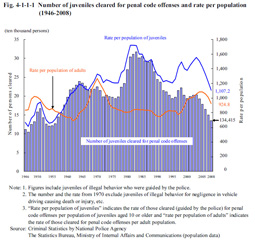| Previous Next Index Image Index Year Selection | |
|
|
1 Juveniles cleared Fig. 4-1-1-1 shows the number of juveniles cleared for penal code offenses (including juveniles of illegal behavior guided by the police; hereinafter the same in this section, unless specified otherwise) and rate per population (rate per population of juveniles aged 10 or older) since 1946 (See Appendix 4-1).There were three peaks in the trend in the number of juveniles cleared for penal code offenses: the first being in 1951 with 166,433, the second in 1964 with 238,830, and the third in 1983 with 317,438. Since 1984 the number had been on a decreasing trend until 1995, but then started increasing from 2001 after going through some slight ups and downs. It started decreasing from 2004 and was 134,415 in 2008. The rate per population of juveniles continued to decrease every year from 2004 to 2008. The number of juveniles cleared in 2008 was at the same level as around 1955 while the rate per population was at the same level as the second peak in 1964. Fig. 4-1-1-1 Number of juveniles cleared for penal code offenses and rate per population (1946–2008) Fig. 4-1-1-2 shows the number of juveniles and adults cleared for non-traffic penal code offenses and rate per population since 1966 (See Appendix 4-2).Fig. 4-1-1-2 Number of juveniles and adults cleared for non-traffic penal code offenses and rate per population (1966–2008) The number of juveniles of illegal behavior who were guided by the police for non-traffic penal code offenses has been on a decreasing trend after reaching three peaks in 1951, 1962, and 1981 (at 67,906). It remained within the range from 20 thousand to 23 thousands since 1999 and fell below 20 thousand for the first time since 1950 in 2006. It further decreased to 17,568 in 2008 (down 336 or 1.9% from the previous year) (See Appendix 4-4). |

